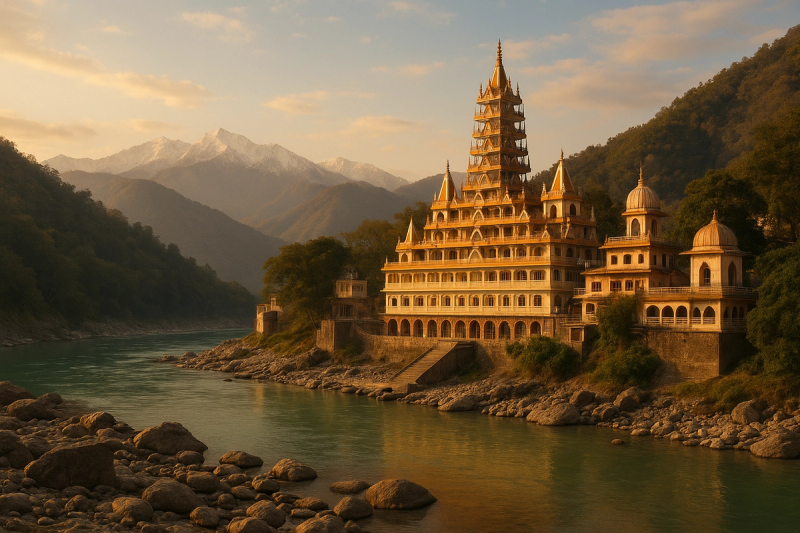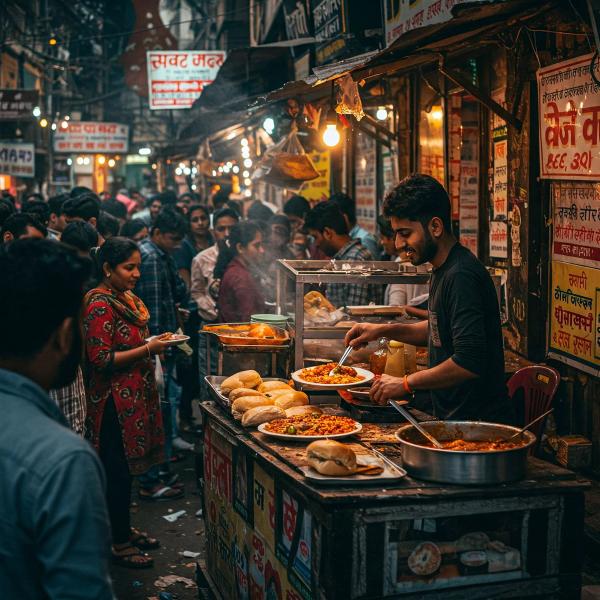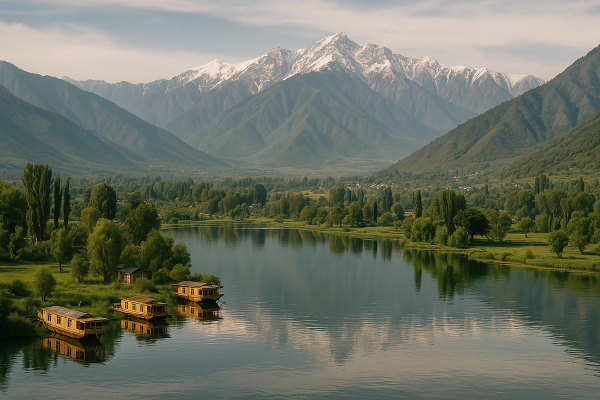Top Religious and Spiritual Sites in Uttarakhand for Indian Tourists — my messy, honest guide#
I’ve been craving that pahadi sunshine and temple bells for ages. So when I finally took off for Uttarakhand, it wasn’t some fancy curated trip. It was me, a small backpack, half-broken chappals (regret), and that stupidly big hope that the mountains would fix a few of my brain tabs. Spoiler: they kinda did. Uttarakhand is not just the Char Dham posters we grew up seeing, it’s the smell of rain on pine, prasad in your palm, and the way everyone says “darshan ho gaya?” like it’s the main KPI of the day.¶
Why Uttarakhand hits different for spiritual travel#
Honestly, there’s a reason every other Indian family has that one uncle who’s obsessed with Kedarnath or Badrinath. The vibe is thick. It’s not just temples, it’s the whole rhythm of life around them. Midday aarti, chai breaks, talking to strangers who somehow share your life philosophy in the queue because you both ran out of breath.¶
- The rivers feel alive. Ganga in Haridwar, Bhagirathi at Gangotri — not just water, literally a personality.
- Temples tucked into forests and meadows. Bells, incense, cedar trees, blue skies… and suddenly you’re softer.
- People are kind. You ask for directions once, they’ll walk you there while telling shortcuts and ghost stories.
- Food is simple and so good: aloo ke gutke, mandua roti, jhangora kheer, bhatt ki churkani — you will eat like a happy mountain goat.
Char Dham Yatra: practical info + the real feel#
So, the big four: Kedarnath, Badrinath, Gangotri, Yamunotri. If you’re doing the full circuit, plan well. Best months are April–June and Sept–Oct. Monsoon (July–Aug) looks romantic in reels but landslides can shut roads randomly and the Yatra often gets paused. Post-Diwali, most high-altitude shrines close for winter. Good to know: as of 2025, online registration for Char Dham is mandatory. Use the official Tourist Care Uttarakhand portal/app — it’s actually helpful for weather alerts and crowd updates. Carry a few hard copies like an old-school parent, mobile network dies when you least expect it.¶
Kedarnath — the mountain monsoon of emotions#
I started with Kedarnath because, idk, something about Shiva and storms. Base is Gaurikund. The trek is around 16–18 km depending on the route. I went slow, drank too much lemon water, and definitely overestimated my fitness. There are pony and palanquin options if needed. Heli services operate from Phata/Sersi/Guptkashi when weather allows — book early, prices swing a lot but generally expect a few thousand rupees per person. At the temple, everything felt… old and steady. Ring-bell steady. Accommodation near the temple is limited and books out fast. GMVN guest houses are decent, 2.5–4k range for a clean room (prices vary), simple veg meals, hot chai after rain that tasted like a hug. Tip: nights are super cold even in May, carry layers and respect altitude — headache or nausea means rest, don’t “push through” like a hero.¶
Badrinath + Mana village — warm springs, cold peaks#
Road to Badrinath is smoother than you’d expect but traffic can be mad during peak season. The temple sits under Neelkanth peak like it’s in a painting. Tapt Kund hot springs feel unreal after a chilly morning. Walk up to Mana, “the last village,” have tea by the Saraswati river, and listen to grandmoms telling Mahabharat stories that suddenly feel very plausible. Stay options range from budget dharamshalas (500–1200) to mid hotels (3k–6k). I stayed in a homely place where aunty served mandua rotis with ghee that tasted like childhood.¶
Gangotri — where the river is a person#
Gangotri is quieter. The temple sits by the river like it was always meant to be. If you’re fit, Gaumukh trek permits are limited — apply in advance. Base at Uttarkashi has lots of simple lodges (1k–2.5k). The air feels crisp, and you will take too many photos of pine shadows on the river because it’s just that pretty. I met a priest who told me, “Yahan darshan bhi, dhyan bhi,” and yeah, it’s true. Mornings are gold.¶
Yamunotri — steep trek, sweet prasad#
From Janki Chatti, the walk up to Yamunotri is short but steep. I’m not gonna lie, my lungs complained. But reaching the temple, getting garma-garam prasad, and the hot spring dips nearby — sab worth it. There are dandi/palanquin services if needed. Start early to avoid sun and crowds, and don’t forget a raincoat; the weather changes like mood swings.¶
Haridwar + Rishikesh — aarti, yoga, and that river-chill#
I did Haridwar first because nostalgia. Har Ki Pauri Ganga Aarti in the evening — arrive 45–60 mins early or you’ll be sitting behind ten tall uncles. Keep your phone safe, the ghat gets crowded. Rishikesh is my comfort city. Ram Jhula side has the ashrams and cafes. Some bridges had renovation updates popping up recently — just follow local notices, don’t over-plan. Parmarth Niketan’s aarti feels peaceful and organized. Ashram stays usually ask for advance bookings; donation-based or fixed (800–1500 per person) including simple meals and yoga. If you’re into yoga festivals, the International Yoga Festival pops every March and the city gets packed — book like way early. Food-wise, try aloo poori at Chotiwala, and that lemon-ginger-honey tea every cafe makes. Little hack: many ashrams offer morning meditation open to visitors, no pressure to join a full course.¶
Neelkanth Mahadev — hilltop temple day trip#
From Rishikesh, Neelkanth is a short drive or a trek if you’re feeling adventurous. The route passes through forest, honestly very soothing. Go early morning to avoid line snaking into the sun. The prasad is simple, laddoos and mishri, but somehow tastes like a blessing. Carry cash; UPI works most places now, but sometimes the machine decides to nap.¶
Hemkund Sahib & Valley of Flowers — bloom and bhakti#
This stretch touched my soul. Base at Govindghat, trek to Ghangaria, and then two separate trails — one to Hemkund Sahib (steep, high altitude), and one to the Valley of Flowers (gentler but long). Hemkund sits at 4,300+ meters, so pace yourself. Doors typically open mid-June and close by Oct, depending on weather. The Valley in peak bloom is wild — pinks, blues, yellows, little fairies of flowers everywhere. Permits are required for the Valley, check the official gates at Govindghat. Stays in Ghangaria are basic (1.2k–3k), but hot rajma-chawal after a rainy trek? chef’s kiss.¶
Kumaon side: Jageshwar, Kainchi Dham, Patal Bhuvaneshwar#
Don’t sleep on Kumaon. Jageshwar has more than a hundred ancient stone temples in a cedar forest — bells echo like time travel. Kainchi Dham near Nainital is trending crazy, lines get long especially on special days and weekends. Arrive early morning, parking is limited, and please dress respectfully — it’s not a selfie park. Patal Bhuvaneshwar is a cave temple near Gangolihat, with formations that look like entire mythologies shaped in stone. And it’s not claustrophobic if you breathe slow, I promise.¶
- Other gems I loved or bookmarked: Tungnath & Chandrashila (highest Shiva temple, trek with sunrise), Kartik Swami near Kanakchauri (view is unreal), Surkanda Devi near Dhanaulti, Dhari Devi near Srinagar, Haidakhan Babaji temple near Ranikhet.
Travel updates & logistics that actually matter now#
- Registration: For Char Dham, do the biometric/online registration in advance through the Tourist Care Uttarakhand app/site. It helps with crowd control and emergency alerts.
- Transport: Delhi to Haridwar/Dehradun has multiple trains, including Vande Bharat to Dehradun. Overnight buses to Rishikesh are frequent from ISBT. From hubs, shared jeeps and local buses go to hill towns — cheap and chaotic, but fun if you’re chill.
- Helicopters: Kedarnath heli runs from Phata/Sersi/Guptkashi when weather is clear. Book official counters/apps, avoid random agents. Prices vary, usually in mid-thousands.
- Network & Payments: Jio worked for me in most places, but when it didn’t, it really didn’t. Keep cash (small notes), UPI is widely accepted but not always.
- Safety: Monsoon can mean landslides and sudden road closures. Follow local advisories, listen to the cops, and don’t argue with the mountains.
- Events: Haridwar sees heavy crowd during Kanwar Yatra (around July). Rishikesh’s International Yoga Festival (March) fills up rooms crazily. Book early or be ready to compromise.¶
When to go & what to carry (stuff I messed up and then fixed)#
Best months for most places: April–June and Sept–Oct. If you’re chasing snow, early spring mornings in higher altitudes are crisp and magical, but nights bite. Monsoon has its own vibe — waterfalls everywhere — but I wouldn’t do high treks then. Pack layers, rain protection, a small torch, power bank, and good shoes (don’t be me with the chappals). For high altitude like Hemkund or Kedarnath, walk slow, hydrate, and if you feel off, rest. Get basic travel insurance. Sunscreen and cap are not optional, the sun burns quietly at altitude.¶
Where I stayed + real costs (approx, so don’t yell if it’s 200 more)#
- Haridwar: Dharamshala near Har Ki Pauri for around 500–900 a night. Clean, close to the ghat, minimal fuss.
- Rishikesh: Ashram stay with meals and yoga for 1–1.5k per person. Dorms are cheaper, private rooms cost more.
- Kedarnath: GMVN or similar lodges 2.5–4k range when available; book way in advance. Simple, warm bedding, hot tea, thank god.
- Badrinath: Mid-range hotels 3–6k, homestays around 1.5–3k. Food everywhere is veg and comforting.
- Ghangaria (Hemkund/VoF): 1.2–3k, very basic but clean enough.
- Kumaon homestays (Jageshwar/Ranikhet side): 1.5–3k, best hosts ever, ask for local food.¶
Food that hugged me#
Garhwali thali with chainsoo (black gram curry), kafuli (leafy green goodness), bhatt ki churkani. Mandua rotis with ghee that tasted like someone cared. Aloo ke gutke with rai and red chillies — crunchy, spicy, perfect with chai. Jhangora kheer for sweet cravings. In Haridwar, kachori-jalebi breakfast is law. Rishikesh cafes do a mean ginger-honey-lemon and sattvik thalis. Do try the local bhang ki chutney only if you know what you’re doing — it’s food tradition, not a party trick.¶
Little mistakes and pro tips I’m passing on#
- Start darshan early. Crowds are kinder at 6 am.
- Carry a proper rain jacket, not the flimsy poncho that flies like a flag.
- Keep photocopies of ID and registration; phones die when you need them most.
- Respect dress codes and temple rules. Don’t push, don’t litter. The mountains remember.
- Hydrate, walk slow, and if a local says “abhi mat jao,” just don’t go.
I went looking for darshan and got… a quieter mind. And a sunburn. And stories. Mostly stories.
Would I go back?#
Easily. Every valley felt like a half-finished poem. I want to do Tungnath sunrise properly without missing the last light. I want to sit longer by the river in Gangotri and not check my phone. Maybe time a trip around the yoga festival, or just go in shoulder season when the crowds thin out and the shopkeepers remember your face.¶
Final travel thoughts#
Uttarakhand is the rare mix — intense faith and chill nature, both at once. It’s imperfect, roads break, plans change, but that’s part of the magic. If you’re planing your own trip, keep it flexible, book the important stuff early, and listen to locals. Oh and if you want more stories and practical guides like this, I keep browsing AllBlogs.in when I’m confused — solid tips, less drama. See you in the hills.¶














